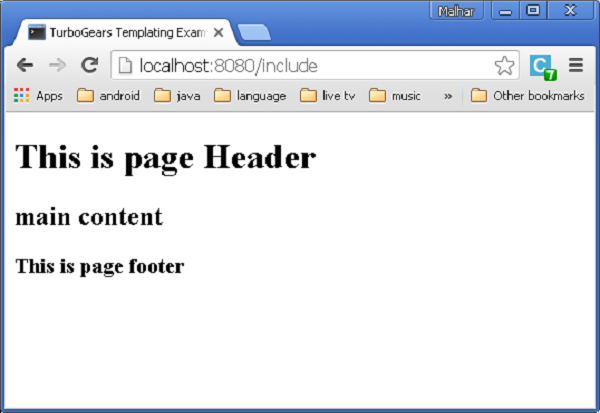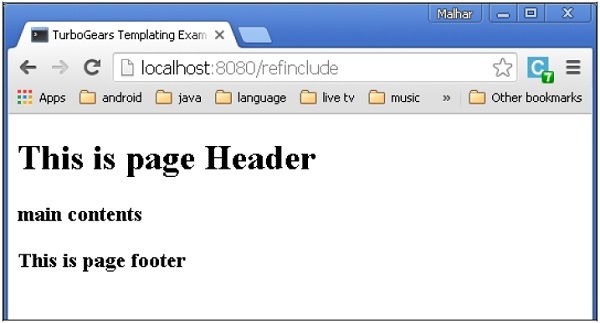
- TurboGears - Home
- TurboGears - Overview
- TurboGears - Environment
- TurboGears - First Program
- TurboGears - Dependencies
- TurboGears - Serving Templates
- TurboGears - HTTP Methods
- Genshi Template Language
- TurboGears - Includes
- TurboGears - JSON Rendering
- TurboGears - URL Hierarchy
- TurboGears - Toscawidgets Forms
- TurboGears - Validation
- TurboGears - Flash Messages
- TurboGears - Cookies and Sessions
- TurboGears - Caching
- TurboGears - Sqlalchemy
- TurboGears - Creating Models
- TurboGears - Crud Operations
- TurboGears - DataGrid
- TurboGears - Pagination
- TurboGears - Admin Access
- Authorization & Authentication
- TurboGears - Using MongoDB
- TurboGears - Scaffolding
- TurboGears - Hooks
- TurboGears - Writing Extensions
- TurboGears - Pluggable Applications
- TurboGears - Restful Applications
- TurboGears - Deployment
TurboGears - Includes
Contents of another XML document (especially HTML document) can be included by using inclusion tags in the current document. In order to enable such an inclusion, XInclude namespace must be declared in the root element of the HTML document.
<html xmlns = "http://www.w3.org/1999/xhtml" xmlns:xi = "http://www.w3.org/2001/XInclude >
The above declaration specifies that include directive contains xi prefix. To add contents of another html page in the current document, use xi:include directive as follows −
<xi:include href = "somepage.html" />
In the following example, root.py contains include() controller, which exposes include.html.
from hello.lib.base import BaseController
from tg import expose, request
class RootController(BaseController):
@expose('hello.templates.include')
def include(self):
return {}
Heading and Footer HTML
In include.html, include namespace is declared and contents of heading.html and footer.html are added. Here is the HTML script of templates\include.html −
<html xmlns = "http://www.w3.org/1999/xhtml"
xmlns:xi = "http://www.w3.org/2001/XInclude">
<head>
<title>TurboGears Templating Example</title>
</head>
<body>
<xi:include href = "heading.html" />
<h2>main content </h2>
<xi:include href = "footer.html" />
</body>
</html>
Here is the templates\heading.html code −
<html>
<head>
<title>TurboGears Templating Example</title>
</head>
<body>
<h1>This is page Header</h1>
</body>
</html>
The following is the templates\footer.html
<html>
<head>
<title>TurboGears Templating Example</title>
</head>
<body>
<h3>This is page footer</h3>
</body>
</html>
Start the development using a gearbox and enter http://localhost:8080/include in the browser. The output rendered will be as shown below −

This way the modular construction of views can be achieved. If the resource mentioned in xi:include directive is not available, an error will be raised. In such a case an alternative resource may be loaded by using xi:fallback.
<xi:include href = main.html> <xi:fallback href = default.html/> </xi.include>
Inclusion of content can be made dynamic as href attribute that can contain expressions.
Add following controller in root.py.
@expose('hello.templates.ref-include')
def refinclude(self):
return {'pages':['heading','main','footer']}
Save following code as ref-include.html in templates folder.
<html xmlns = "http://www.w3.org/1999/xhtml"
xmlns:py = "http://genshi.edgewall.org/"
xmlns:xi = "http://www.w3.org/2001/XInclude">
<head>
<title>TurboGears Templating Example</title>
</head>
<body>
<xi:include href = "${name}.html" py:for = "name in pages" />
</body>
</html>
Before starting the server make sure that templates folder has a heading.html, main.html and footer.html. Enter http://localhost:8082/refinclude in the browser to get the following output
